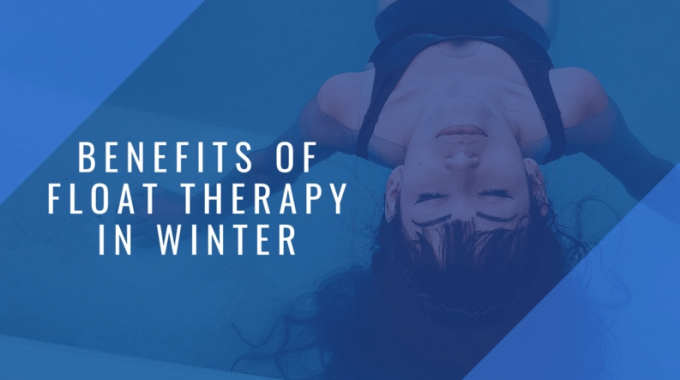
The Benefits Of Floating For Sleep And Mental Health
Article first appeared at thesleepdoctor.com by | May 28, 2019 | Health, How to Sleep Better
How floating improves sleep
Evidence dating back decades demonstrates that float therapy can be effective in treating sleep problems, including insomnia. For example, a study from 1989 found that a series of four 2-hour floatation sessions over a 2-week period led to improvements in symptoms of insomnia. Participants who received float therapy experienced reductions to their sleep latency—in plain terms, that means they were able to fall asleep more quickly. The improvements to sleep lasted for up to 12 weeks after the float session, indicating that floating as a sleep therapy can have lasting effects beyond the short-term.
More recent research has also demonstrated benefits for sleep from floating. This 2014 study by Swedish scientists found significant improvements both to sleep amounts and to the quality of sleep in people who underwent a series of twelve 45-minute float sessions over a 7-week period. And a 2017 study found some fascinating information about how float therapy alters brain activity in ways that mimic some aspects of sleep itself. Researchers used an EEG tool to measure brainwaves during float sessions, and found that floating led to a shift into a deeply relaxed state of consciousness. The brain activity and consciousness scientists measured during floating was similar to that of Stage 1 sleep. Stage 1 is the lightest stage of sleep, a state of highly mixed consciousness, when we feel highly drowsy, often partially aware of being awake, when our thoughts roam in a dreamlike way and we’re cut free from a sense of time. During Stage 1 sleep, blood pressure and heart rate drop, as the body itself moves into a resting state.
If you read my first article on floating and sleep, you’ll remember my patient who described losing her sense of time (quite happily) while in her float session. Her experience aligns with what this research shows of the neurological and physiological relaxation responses that float therapy creates.
Given what we know about the physiological effects of floatation, including its ability to lower cortisol and boost low-frequency brain activity, it’s not surprising to me to see this evidence of a direct benefit for sleep. High cortisol levels and an active, task-focused brain (dominated by high-frequency beta waves) make falling asleep and staying asleep much more difficult. I’m looking forward to seeing additional research that explores these sleep benefits in more depth, and continues to measure the durability of floating as a therapy to provide lasting improvements to sleep.
Floating to treat anxiety, depression, and other psychological conditions
Anxiety and depression are significant sleep-disruptors; any improvements to symptoms of these conditions can also provide substantial benefits for sleep. And, of course, looking beyond sleep, these conditions pose serious complications for health, safety, well-being, productivity and quality of life. Anxiety and depression often occur together, and one or both are present in most people who have sleep problems. Over a lifetime, a third or more of people will experience some form of anxiety disorder, nearly 20 percent in any given year. Nearly 10 percent of us will experience a major depression at some point in our lives (for women, the risk is twice as high as men), and many more of us will grapple with symptoms of depression and low mood.
Some of the most interesting and promising recent research investigating float therapy involves its impact on anxiety and depression, and other mental health conditions that co-occur with them.
A 2016 study examined the effects of 12-sessions of floatation therapy in a group of adults with generalized anxiety disorder. Compared to a control group, the people who underwent float therapy experienced significant reductions to anxiety, with 37 percent achieving full remission from their anxiety disorder by the end of the 12-week treatment period. The people who received float therapy also had sizeable improvements to their sleep, to symptoms of depression, and to their ability to regulate their emotions. With the exception of depression, all these gains were still present at a 6-month follow-up check-in.
A 2018 study found floatation therapy worked quickly to provide short-term relief for both anxiety and depression. This study examined the impact of a single float session for people with a range of anxiety disorders, including generalized anxiety, PTSD, panic, and social anxiety. Measurements taken before and after a 1-hour float session found significant improvements to anxiety, as well as depression, stress, and physical pain. At the same time, the participants experienced an increase to their sense of happiness, relaxation, and well being.
Among a group of people with high levels of anxiety, floatation therapy reduced psychological symptoms of anxiousness, as well as muscle tension and blood pressure, as seen in the results of another study from 2018. At the same time, highly anxious people who underwent floating experienced big gains to relaxation, and feelings of serenity. Scientists also measured an increase in the degree of interoceptive awareness—that’s an awareness of the self, of body, mind, and feelings. Enhanced interoceptive awareness is one of the hallmarks of a mindful, meditative state—and it’s one essential part of what makes meditation and mindfulness so effective in helping with emotional regulation, stress, physical pain and psychological trauma.
One of the most exciting prospects of floatation therapy is the ability it appears to have to move people quickly and deeply into a physical and psychological state of meditation. I’ve lost count of the number of people—patients, friends, and colleagues—who tell me how much they want to meditate, and how tricky they find it to establish a routine that feels successful. Floatation therapy may be a way to tap in to a direct line to this often-sought meditative state of mind.
Another recent scientific investigation illustrates the potential of floatation therapy in treating a range of mental health issues and improving quality of life. This is a study of a single patient, a young woman with several co-occurring psychological conditions: PTSD, ADHD, autism, anxiety and depression. The young woman initially sought out float therapy to find relief from headaches she associated with the stimulant and anti-anxiety medications she was taking. That began a long-term course of floatation therapy. This patient floated 50 times over a period of a year and a half, an average of slightly more than 2 times a month. Scientists tracked and analyzed her progress through more than 2 years of regular float therapy. They found she made some dramatic gains to her health, sleep, and quality of life. This patient experienced:
- Deep psychological and physical relaxation during floating sessions, the short-term benefits of which extended beyond the sessions themselves
- Marked improvements to her anxiety and depression, including significant increases to self-confidence, reductions in social anxiety, and a greater ability to meet challenges in life
- Relief from fatigue and sleep problems
- An ability to be more active and accomplish more in her daily life, accompanied by positive feelings, and a newfound sense of being capable, resilient, and secure
This patient was able to stop taking all medications during the course of regular floatation therapy. At a 2-year follow up, she was still not taking medication and had stopped smoking. At that point, this patient was continuing to use float sessions on a monthly basis.
Another case study, of a woman with ADHD, autism, anxiety and depression who underwent a series of float sessions, demonstrated similar benefits to quality of life, emotional regulation, sensory processing, independence and a sense of calm.
These individual case studies can’t tell us all we need to know about floating’s therapeutic benefits—we need larger studies to measure the psychological effects of floating, in the short and long term. But these studies of individuals are compelling, and do provide a glimpse of what the benefits of floating may indeed be. And there is other research that aligns with the experiences that scientists have documented in these case studies. Several studies have shown that REST (remember, that’s restricted environmental stimulation therapy) can be effective in treating addictive behaviors, including nicotine addiction. And other research indicates that floating can help people with post-traumatic stress reduce anxiety and physical pain. We need more research into the possible usefulness of floatation therapy for people with ADHD and ASD, or autism spectrum disorder. Diagnosis of these disorders has been on the rise for decades, and identifying safe, effective non-drug treatments needs to be a top public health priority.
Floating eases stress and ‘burnout’
Stress, in its many forms, is among the most persistent, debilitating obstacles to sleeping well. What forms does stress take? There’s acute stress—an intense, short-term response to unexpected or disruptive experiences. Acute stress is what we feel when we have a fight with our partners, narrowly avert an accident or miss an important deadline at work. Acute stress is also a response to traumatic experiences of violence, abuse, and loss—and in these cases, that short-term stress response can often linger and transform into chronic stress and anxiety.
It’s not only trauma that creates chronic stress. Many people experience a constant presence of stress in their daily lives. Often, we don’t even realize we’re living with stress that never subsides. But evidence of chronic stress can show itself—in problems with sleep, in anxious, irritable, low mood, in fatigue and physical pain throughout the body. The constant presence of stress creates a state of hyperarousal in the brain and body that never entirely goes away. Cortisol levels become elevated, the immune system suppressed, the brain highly vigilant, alert, and threat-focused. This state of physical and psychological arousal can have serious negative effects on sleep and contribute to other chronic health issues, including cardiovascular and metabolic problems, gut dysfunction, anxiety and depression.
And what about burnout? “Burnout” is a non-medical term that is usually used to describe a kind of stress and exhaustion that stems specifically from work.(In truth, burnout can be the result of emotional and physical strain and exhaustion that isn’t exclusively work-related.) Burnout often arises from an intense, unrelenting workload, being constantly “plugged in” to work, and lack of social and emotional support. Needless to say, in today’s 24-7 culture, we’re hearing A LOT about burnout. Anyone is susceptible to this type of stress. People in helping professions, including unpaid, informal and family caregivers, are especially vulnerable
From what we know about floating, both from personal reports and scientific inquiry, it can be a potent antidote to stress and burnout. A review of more than 2 dozen studies investigating floatation REST therapy found the practice to be an effective tool for lowering stress, increasing a sense of well being, and improving daily performance. Remember, stress has both psychological and physiological components. In addition to psychological improvements, the body of research analyzed in this study found significant evidence of positive physical changes related to stress, including lower cortisol levels and lower blood pressure.
This 2014 study also found significant reductions to stress accompanied by a boost to energy and optimism, from a 7-week period of floatation therapy that included 12 individual float sessions. It’s worth pointing out (as the study’s scientists themselves did), that many of this study’s participants offered (without being asked) comments to researchers about their float experiences. Many of them talked about the dramatic relief from physical pain that came from floating. (More on the benefits of floating for pain in just a minute.) They also spoke about their never-before experienced degree of relaxation and relief from tension and stress.
A small group of studies has investigated the potential of floatation therapy to address burnout. A 2010 study found that 10 weeks of floatation therapy, in combination with psychotherapy, led to improvements in quality of life and psychological well being, and relief from burnout that allowed the study participants to continue to work full time. Another study investigated the long-term effects of floatation. After a series of 12 float sessions, participants in this study experienced major improvements to stress and the symptoms of burnout. Researchers found that these benefits were still in place 4 months after treatment ended.
Overall, the research indicates that floatation therapy can be a very powerful tool for stimulating the body’s relaxation response. Like meditation and yoga, floatation is another mind-body therapy that needs to be given serious consideration and attention as a tool to address stress.




